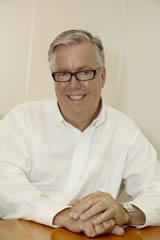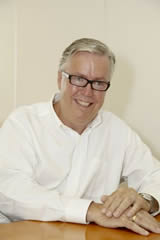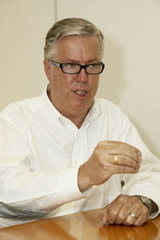30 Minutes with Lars Nittve
 Lars Nittve, the renowned museum director and curator formerly of the Tate Modern in London and Moderna Museet in Stockholm, was recently appointed Executive Director, M+. He is scheduled to begin working with the West Kowloon Cultural District Authority in January 2011, where he will be responsible for refining the vision, mission and artistic direction of M+ in the district. Mr Nittve will also be responsible for overseeing the management and operations of M+, exploring acquisition targets for the museum’s collection, curating and developing exhibitions, and spearheading efforts to enhance public awareness and education about visual arts. Lars Nittve, the renowned museum director and curator formerly of the Tate Modern in London and Moderna Museet in Stockholm, was recently appointed Executive Director, M+. He is scheduled to begin working with the West Kowloon Cultural District Authority in January 2011, where he will be responsible for refining the vision, mission and artistic direction of M+ in the district. Mr Nittve will also be responsible for overseeing the management and operations of M+, exploring acquisition targets for the museum’s collection, curating and developing exhibitions, and spearheading efforts to enhance public awareness and education about visual arts.
Mr Nittve recently sat down to talk about his background, how he will approach his new job, and his aspirations for M+ and the WKCD.
If there are just a few things everyone needs to know about you, what would they be?
Oh dear… I’m Swedish, born and raised in Stockholm. I’m 56, but I‘ll turn 57 in a couple of months. My wife is an architect, and I have a son who is 21 years old and moving into the advertising industry.
Something that amuses people is that I thought I should be in the finance sector. While at the Stockholm School of Economics I got in touch with art through a friend I made there who came from a family of art collectors and art dealers, and I started going to exhibitions with him. And that, for me, was like a coming home. It was a very strong experience, which ultimately led to my decision—of course to the despair of my parents!—to leave and start studying art history instead. But when I did that, I suddenly was energized. I was a different person. So I arrived at art quite late, but when it happened, it happened with full force.
Besides that, I’m just like Graham [Sheffield, WKCD Authority CEO]—I’m an avid skier. I was a ski instructor early on, and I can still ski. But here I’ll probably have to go to Hokkaido!
Going from economics to art history seems to be a very left-brain to right-brain jump.
To the extent that that theory is correct, I think it is. Being a museum director, you need both sides. In a sense you could say it’s an almost impossible job because you must have total authority in the field of art, and at the same time it’s partly like running a business.
I think that’s part of the reason why museum expertise has to be imported all the time., that’s also a common practice in other parts of the world. My predecessor in Stockholm was English; I was the first director of the Tate Modern; the first director of Centre Pompidou was a Swede; etc. It’s really about securing certain skills and experiences, then building around that with knowledge about the local and regional situation. And it’s always about teamwork. I don’t even pretend to know everything about Swedish art! I need young curators who go into the studios all the time. You always depend on your collaborators. It’s not a one-man show.
 What are your impressions of Hong Kong? What are your impressions of Hong Kong?
Fantastic! I love it! It’s really one of the greatest places in the world. I love the fact that it’s a metropolis. It’s Chinese, but it’s also a place where, as a foreigner, you can feel like you belong. You can move around like you can in a city like New York or London. There aren’t that many places that are proper metropolises. If you go to Paris, it’s very French. If you go to Tokyo, it’s very Japanese. Hong Kong is different in that sense. The location is phenomenal; it looks great; and you have nature so close. I think it’s one of the greatest places of the world.
From an artistic point of view, what made Hong Kong an attractive proposition?
The main reason is that there is a commitment to do something extraordinary and innovative, on a large scale. And because in Hong Kong two cultures meet here, the consequences when you do something here are bigger than almost anywhere else in the world. And of course, the art from this part of Asia is getting more and more important. It’s the right place, at the right time, and with the right ambition. How could you resist that?
You’ve been a curator and museum director for much of your career. What does that entail, and what does it mean you will be doing at M+?
We’ll start thinking in detail about: What is a museum in the 21st century? A museum that thinks new about things? And then, from dialogue with different stakeholders in Hong Kong and elsewhere—with artists, with those in the art market, collectors, and also with the Authority—we will form a more precise vision for the museum and the collecting strategy. From that vision grows a programme. Of course, I will play an important role in the selection of an architect for the museum building. Then it’s about building a team that can deliver this vision over the years.
What we will also try to do is not wait for five, six years to give the public an experience of what this could be, but deliver a programme—hopefully next year—in a more “nomadic” way, without a building, so that people can really feel that there is something new happening in Hong Kong in the arts field. So, it’s creating a living museum before it exists, almost.
You’ve worked at a number of leading museums around Europe, in Copenhagen, Malmo, London and Stockholm. How will you apply those experiences to what you will do here?
I think experience works like this: It’s not like you copy what you did in another place, but when you’re facing something that needs to be resolved, you have a number of tested solutions. It doesn’t mean that we’ll do it the Tate Modern way or the Stockholm way; it’s more to have a register of possibilities. This gives a sense of basic security. You don’t get nervous every time you’re confronted with something new. You don’t go in all the wrong directions immediately.
 What are some of the similarities and differences between what you’re going to be doing here and what you did previously? What are some of the similarities and differences between what you’re going to be doing here and what you did previously?
Tate Modern is the most similar because I came in two years before the opening of a major museum, which was the largest museum project since the Centre Pompidou in the 1970s. The difference of course, is that it was linked into an existing museum structure, Tate Gallery, which had existed for 100 years. So there were existing working models, and there was already existing staff who had views on what you were doing. You had to adapt to an existing structure in a sense.
Of course, here everything is from scratch, which could be seen as daunting, but it’s also liberating. I would rather look at the liberating aspect of it … that you can actually think in a freer way. |

